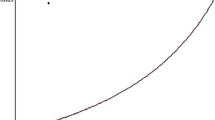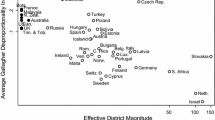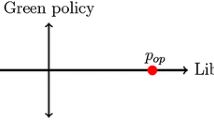Abstract
This article studies the long-run dynamics of policy choices, government formations, and voting behavior under a parliamentary constitution and proportional representation. I develop an infinite period game where, in each period, voters participate in a proportional representation election, and three farsighted parties bargain over one-dimensional policy programs and government positions. The model incorporates the interaction between elections and coalition bargaining, which is the essence of politics in most parliamentary systems, as well as a dynamic environment of policymaking: a policy once implemented remains in effect until another replaces it. I find a Markov perfect equilibrium in which (1) there is no majority party in any election; (2) election results converge over time to a stable vote distribution; (3) policy outcomes change over time but eventually stay within a set of three points; (4) minimal winning coalitions and minority governments are formed with positive probability and alternate over time.


Similar content being viewed by others
Notes
A well known exception is the United Kingdom where the first-past-the-post system is used to elect MPs to the house of the commons.
We interpret this fixed prize as cabinet posts or ministerial portfolios.
We implicitly assume that an inactive caretaker government takes government positions until the next election if no agreement is reached in the government formation process.
For election result to be well defined, \(b(\cdot|x)\) must be measurable for every \(x\in X\).
In our equilibrium, each party would implement its own ideal points if it commanded a majority of seats. Then, for example, when the status quo is moderate, the right party represents two policies: it would propose policy θ if it were a majority party, and it would propose policy \(\bar{x}(\delta,\theta)\) to the middle party in the right-center coalition. Voters whose ideal points are between \(\frac{1}{2}\bar{x}(\delta,\theta)\) and \(\frac{1}{2}\theta\), though they prefer the middle party’s ideal point to the right party’s, will vote for the right party, because the right-center coalition is their best outcome. The complete equilibrium strategies are available in the Appendix.
For example, there is a trivial MPE in which more than half of voters always vote for the middle party, and the middle party, as a majority party, always implements its ideal policy. However, this equilibrium is not robust against a slight change in the formateur selection process, as Cho (2013b) shows in his single period model.
References
Austen-Smith, D., Banks, J. S. (1988). Elections, coalitions, and legislative outcomes. American Political Science Review, 82(2), 405–422.
Bargsted, M. A., Kedar, O. (2009). Coalition-targeted dubergerian voting: How expectations affect voter choice under proportional representation. American Journal of Political Science, 53(2), 307–323.
Baron, D. P. (1996). A dynamic theory of collective goods programs. American Political Science Review, 90(2), 316–330.
Baron, D. P., Diermeier, D. (2001). Elections, governments, and parliaments in proportional representation systems. Quaterly Journal of Economics, 116(3), 933–967.
Baron, D. P., Ferejohn, J. A. (1989). Bargaining in legislatures. American Political Science Review, 83(4), 1181–1206.
Baron, D. P., Diermeier, D., Fong, P. (2012). A dynamic theory of parliamentary democracy. Economic Theory, 49(3), 703–738.
Battaglini, M., Coate, S. (2008). A dynamic theory of public spending, taxation, and debt. American Economic Review, 98(1), 201–236.
Bawn, K. (1999). Voter responses to electoral complexity: Ticket splitting, rational voters and representation in the federal republic of germany. British Journal of Political Science, 29(3), 487–505.
Cho, S. (2012). The dynamics of parliamentary bargaining and the vote of confidence. (unpublished manuscript).
Cho, S. (2013a). The influence of pork on the dynamics of continuing policies. (unpublished manuscript).
Cho, S. (2013b). Voting equilibria under proportional representation. American Political Science Review. (forthcoming).
Diermeier, D., Fong, P. (2011). Legislative bargaining with reconsideration. Quaterly Journal of Economics, 126(2), 947–985.
Duggan, J., Kalandrakis, T. (2012). Dynamic legislative policy making. Journal of Economic Theory, 147, 1653–1688.
Fong, P. (2006). Dynamics of government formation and policy choice. (unpublished manuscript).
Jeon, J. S. (2012). A dynamic model of endogenous political power: The emergence and persistence of oligarchy. (unpublished manuscript).
Kalandrakis, T. (2004). A three-player dynamic majoritarian bargaining game. Journal of Economic Theory, 116(2), 294–322.
Kalandrakis, T. (2010). Minimum winning coalitions and endogenous status quo. International Journal of Game Theory, 39, 617–643.
Kedar, O. (2005). When moderate voters prefer extreme parties: Policy balancing in parliamentary elections. American Political Science Review, 99(2), 185–199.
Müller, W. C., Strøm, K. (Eds.) (1999). Policy, office, or votes?: How Political Parties in Western Europe Make Hard Decisions. NY: Cambridge University Press.
Nunnari, S. (2011). Dynamic legislative bargaining with veto power. (unpublished manuscript).
Penn, E. M. (2009). A model of farsighted voting. American Journal of Political Science, 53(1), 36–54.
Romer, T., Rosenthal, H. (1978). Political resource allocation, controlled agendas, and the status quo. Public Choice, 33(4), 27–43.
Tsebelis, G. (1986). A general model of tactical and inverse tactical voting. British Journal of Political Science, 16(3), 395–404.
Acknowledgements
I specially thank John Duggan for his advice in many stages of developing this paper. I am also grateful to Editor-in-chief of this journal, Jane Bang, Tim Feddersen, Mark Fey, Garrett Glasgow, Tasos Kalandrakis, Insun Kang, Bing Powell and seminar participants at Harvard University, at Princeton University, and at Washington University for their helpful comments and discussions.
Author information
Authors and Affiliations
Corresponding author
Rights and permissions
About this article
Cite this article
Cho, Sj. Three-party competition in parliamentary democracy with proportional representation. Public Choice 161, 407–426 (2014). https://doi.org/10.1007/s11127-014-0165-3
Received:
Accepted:
Published:
Issue Date:
DOI: https://doi.org/10.1007/s11127-014-0165-3




